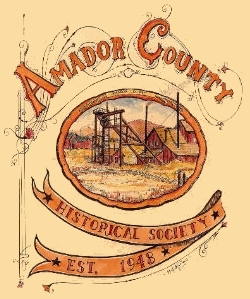 |
 |
| |
|
|
 |
|
| |
|
 This 15-room classic Greek Revival dwelling, was constructed in 1859 as a home of Armstead C. Brown, one of Jackson's earliest settlers. The museum features a fascinating array of artifacts and items from the county's early days. This 15-room classic Greek Revival dwelling, was constructed in 1859 as a home of Armstead C. Brown, one of Jackson's earliest settlers. The museum features a fascinating array of artifacts and items from the county's early days.
Collections include a Gold History Exhibit, fashions of the past, a Victorian bedroom and parlor, a Native American collection, a Chinese American collection, and much more. The museum at 225 Church Street overlooks historic downtown Jackson.
Open Friday, Saturday & Sunday
11am to 3pm
225 Church Street, Jackson, CA
We invite you to visit us often... History, literally, "lives here."
CONTACT US FOR SPECIAL TOUR TIMES AND DATES
|

Kennedy & North Star Mine Model Exhibits
Take a trip back in time to the 1920's and watch replicas of equipment of the Kenndy and North Star Mines in operation through the magic of large scale working models. The three models demonstrate the functions of a headframe hoisting equipment, the stamp mill and the famous Kennedy Mine Tailing Wheels.
Tours are conducted Fri., Sat. & Sun. at 12 noon and 1pm. Group tours can be arranged for any day at any time by calling 209-257-0332 for arrangements.
The exhibit is located on the same property as the Amador County Museum at 225 Church Street.
|
Museum Building History
In 1849 A. C. Brown, older and more established than most gold seekers, left his Wisconsin home and law profession to "see the elephant" in the gold fields. Before coming to Jackson in 1850 or 51, he mined in what is now Shasta County, and is credited with actually naming the camp of Shasta City.
He arrived in Jackson in 1850, liked what he saw, and determined to bring his family west and settle. Thus overland he went again in 1851 to get family and return to Jackson. By 1852 the Browns lived in a rude, frame building near today's corner of North and North Main, which later became the first Catholic church in the village. Brown quickly began investing in town lots and buildings, and lived in more than one of them before moving into the new home circa 1859.
In early day Jackson, when the town was in Calaveras, Brown was a town trustee. He concentrated on his law practice, and his rental units. It the late 1860s he served a term as a legislator, and the next decade served a 2-year term as county judge.
Judge Brown served his community for a half century before his death in 1902. With his and wife Philippa's death, youngest son George W. Brown lived in the family home until 1947. Collateral Brown heirs sold the home to the county.
Entering the museum is a step back in time. It features a fascinating array of artifacts and items from the county's early days as a neglected "province" of Calaveras, the formation of Amador in 1854, and present day displays and exhibits. Visitors may wander through the many unusual exhibits that fill the 15-room home, with nostalgic background music setting the right restful ambiance.
The museum collections include: a "Gold History Exhibit," "Dressed to the Nines" or fashions of the past; a sewing and quilt exhibit; a Victorian bedroom and parlor; a Native American collection; a Chinese American collection; an old fashioned school room and much more.
|
| |
|
|



